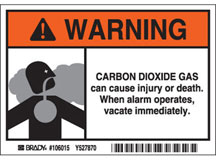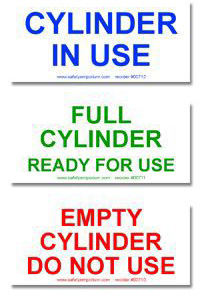



Find all of your laboratory and workplace safety supplies at Safety Emporium!
 Asphyxia |
 Glossary Index |
 Asphyxiation |
| MSDS Topics |
Free Sites | FAQ's | Regulations | Glossary | Software | Suppliers |
| Books | Forum | Poll | Fun stuff | Quiz | Store | |
| Understand your MSDS with the MS-Demystifier | Search ALL our MSDS info | |||||

All rooms with fixed extinguishing systems must have appropriate warning signs like this one from Safety Emporium.
An asphyxiant is a substance that can cause unconsciousness or death by suffocation (asphyxiation). Asphyxiants which have no other health effects and are sometimes referred to as simple asphyxiants.
29 CFR 1910.1200, the OSHA Hazard Communication Standard, defines a simple asphyxiant as a substance or mixture that displaces oxygen in the ambient atmosphere, and can thus cause oxygen deprivation in those who are exposed, leading to unconsciousness and death
.
Asphyxiants work by displacing so much oxygen from the ambient atmosphere that the hemoglobin in the blood can not pick up enough oxygen from the lungs to fully oxygenate the tissues. As a result, the victim slowly suffocates.
Asphyxiation is an extreme hazard when working in enclosed spaces. Be sure you are trained in confined space entry before working in sewers, storage tanks etc. where gases such as methane may displace oxygen from the atmosphere. Be aware that some asphyxiants are heavier or lighter than air and can concentrate near floors or ceilings. See the Further Reading links below for an example of where a worker died from asphyxiation because carbon dioxide invisibly pooled in a stairwell.
Workplaces that use asphyxiants should establish training and protocols to prevent accidental releases as well as measures to take in the event of an accident. In 2021, six workers were killed and a dozen were injured at a poultry processing plant when a freezer malfunctioned and released nitrogen gas into a closed room. OSHA found that these deaths were completely preventable and cited the three companies involved in the operation for 59 safety violations and assessed $998,637 in penalties.
Oxygen level alarms should be installed in any room where sudden release of an asphyxiant could displace oxygen to a level that is immediately dangerous to life or health (IDLH).
The normal composition of air is:
| Gas | Chemical Formula | Percent by Volume |
| Nitrogen | N2 | 78.03 |
| Oxygen | O2 | 20.99 |
| Argon | Ar | 0.94 |
| Carbon Dioxide | CO2 | 0.033 |
| Neon | Ne | 0.0015 |
According to the Canadian Centre for Occupational Health and Safety (CCOHS) the health effects of asphyxiation are:
| % O2 by volume | Symptoms or effects |
| 16 to 12 | Breathing and pulse rate increased, muscular coordination slightly disturbed |
| 14 to 10 | Emotional upset, abnormal fatigue, disturbed respiration |
| 10 to 6 | Nausea and vomiting, collapse or loss of consciousness |
| Below 6 | Convulsive movements, possible respiratory collapse and death |
Examples of asphyxiating gases are nitrogen (N2), helium (He), neon (Ne), argon (Ar), methane (CH4), propane (CH3CH2CH3), and carbon dioxide (CO2).

Safety Emporium has a great lineup of gas cylinder signs, storage racks, clamps and more.
All of the asphyxiants listed above are odorless and tasteless except carbon dioxide and propane that has been commercially odorized. You can become unconscious by inhalation of these gases without realizing they are present. Again, follow OSHA-approved protocols for confined space entry into sewers, storage tanks etc. Also note that some of these materials (methane and propane, for example) are also flammable and can form a flammable mixture in air.
Remember also that simple air-purifying respirators or dust masks do not protect you from asphyxiation in an oxygen-deficient atmosphere. See the first link below for accidents involving supplied air respirators!
Under HCS 2012 and the GHS a simple asphyxiant" must utilize the signal word "Warning" and the hazard statement "May displace oxygen and cause rapid suffocation" on both the product label and Safety Data Sheet. MSDS's and labels prepared before HCS 2012's SDS provisions took full effect in on June 1, 2015 (December 1, 2015 for labels) may lack these indicators. On some older MSDS's the abbreviations S/A or SA were sometimes used for "simple asphyxiant".
Simple asphyxiants have no pictogram requirement under HCS 2012.
See also: air, anoxia, asphyxia, asphyxiation, IDLH - Immediately Dangerous to Life or Health.
Additional definitions from Google and OneLook.
Entry last updated: Sunday, February 27, 2022. This page is copyright 2000-2025 by ILPI. Unauthorized duplication or posting on other web sites is expressly prohibited. Send suggestions, comments, and new entry desires (include the URL if applicable) to us by email.
Disclaimer: The information contained herein is believed to be true and accurate, however ILPI makes no guarantees concerning the veracity of any statement. Use of any information on this page is at the reader's own risk. ILPI strongly encourages the reader to consult the appropriate local, state and federal agencies concerning the matters discussed herein.